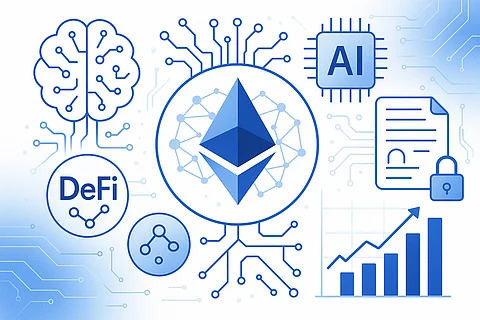Ethereum is currently experiencing a significant resurgence, driven by the powerful convergence of artificial intelligence and its robust blockchain infrastructure, a trend prominently highlighted by leading market analysts. This renewed momentum positions Ethereum not merely as a cryptocurrency, but as a foundational layer for the burgeoning tech economy, attracting substantial institutional capital seeking strategic early positions.
Nomy Research, a key voice in crypto market analysis, identifies the accelerating fusion of AI with blockchain as a pivotal long-term growth catalyst for Ethereum. While much of the broader market fixates on conventional macro trends, forward-thinking institutional investors are reallocating assets with a keen eye on this technological convergence, recognizing Ethereum’s potential as the essential base layer for AI-native applications.
The network’s architectural strengths underpin this optimistic outlook, including its high composability, the standardized Ethereum Virtual Machine (EVM), and a rapidly expanding Layer 2 ecosystem. With over $90 billion in total value locked across Ethereum protocols—representing nearly 60% of the global decentralized finance market—and hundreds of thousands of smart contracts deployed, its maturity offers a distinct advantage in enabling diverse AI use cases such as decentralized data processing, autonomous agent coordination, and incentivized compute markets.
“The convergence of AI and Ethereum is not just technological, it’s strategic,” affirms Mackenzie Blaeser, a prominent researcher at Nomy. This sentiment reflects a shift among institutional allocators, who are no longer debating market entry but actively strategizing on how to optimally position themselves across various layers of the evolving crypto ecosystem, signaling a profound belief in Ethereum’s long-term value.
This strategic capital rotation is evident in Ethereum’s recent market performance. While Bitcoin consolidates, Ethereum has demonstrated a strong rebound, reflecting robust on-chain activity and renewed capital inflows. This divergence indicates a sophisticated reassessment of long-term investment strategies by institutional players, moving beyond a simple follow-the-leader mentality.
Staking continues to be a cornerstone of Ethereum’s ecosystem, with roughly 29% of its total supply now staked, amounting to over 36 million ETH. The consistent growth in new validators further validates the network’s stability and appeal. Significantly, Ethereum-linked exchange traded products (ETPs) recorded global net inflows exceeding $4 billion in July alone, including a record-setting $1.6 billion in a single week, dramatically reversing previous outflow trends and underscoring renewed institutional confidence.
The renewed institutional interest, spurred by the AI narrative, is simultaneously boosting decentralized finance (DeFi) protocols. Nomy Research points to increased capital flows into established platforms like Aave, MakerDAO, and Lido, alongside newer platforms specifically designed for AI-centric functions such as compute delegation and liquidity routing. While projects such as Gensyn, Bittensor, and Render Network are drawing early attention, their institutional adoption remains nascent, yet Ethereum’s foundational blockchain infrastructure provides the crucial backbone they depend on for future integration with AI-driven services.
In this dynamic landscape, sophisticated platforms are emerging as flexible tools for institutional capital management, offering enhanced strategies beyond base ETH staking yields. The escalating rise of artificial intelligence is fundamentally reshaping global technology and capital markets, solidifying Ethereum’s perception not merely as an altcoin, but as essential core Web3 infrastructure, akin to the transformative role of cloud computing platforms during the Web2 era.






Leave a Reply